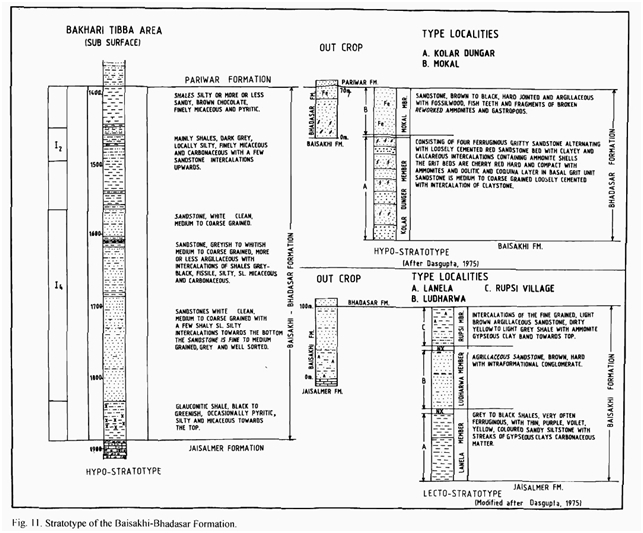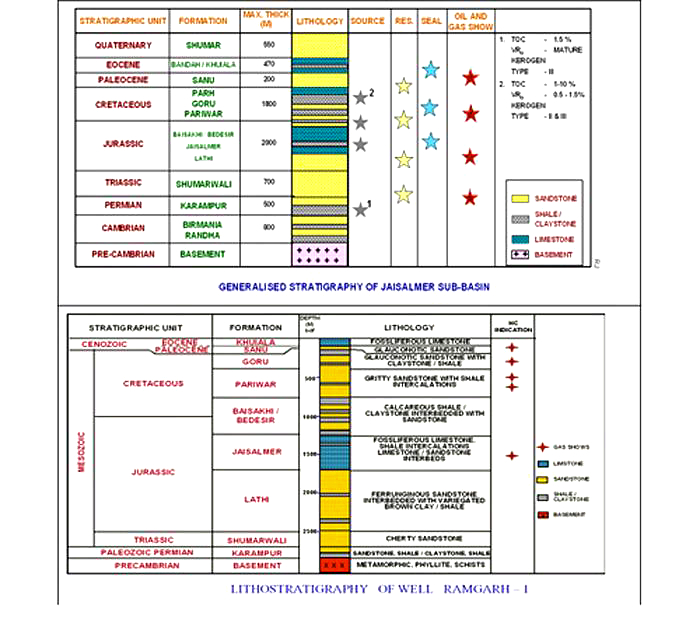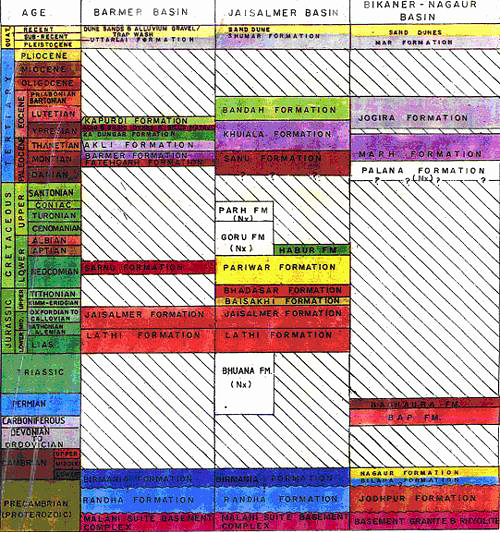Bhadasar Fm
Type Locality and Naming
OUTCROP. Exposures at Bhadasar scarp. Besides, outcrops of Bhadasr Formation are present at Kolar Dungar and Mokal Village.. [Original Publication: Swaminath, J., Krishnamurthy, J.G., Verma, K.K., and Chandak, G.J., 1959, General geology of Jaisalmer area, Rajasthan, ECAFE Symposium, Mineral Research and Development Series 10: 154-155]
Synonyms: This formation was first named by Oldham (1886) as "Bedesir beds" after village Bhadasar. Later on Allison (1938, referred in Arkell, 1956) described it as "Bedesir Group". Swaminath et al. (1959) dropped the word 'Group' and proposed it as "Bedesir Formation" without giving type section and also did not discuss about vertical and lateral lithofacies. Subsequently, Narayanan et al.(1961) and Dasgupta (1975) discussed lithology in detail from the type area. The latter author also subdivided the formation into two members namely Kolar Dunger and Mokal.
Lithology and Thickness
Sandstone. The formation is mainly an arenaceous sequence composed of ferruginous sandstone at places gritty with thin intercalation of clays (Fig. 1).
The formation is further divisible into two members:
1) Kolar Dungar Member. This member comprises alternations of ferruginous gritty sandstone and loosely cemented sandstone beds with calcareous clay intercalations containing broken ammonite shells. In Bhadasar scarp a thin coquina bed has been reported from basal gritty sandstone. From its upper section giant ammonites have been collected from Nimar river section in south west of Bhadasar.
2) Mokal Member. It comprises brown, hard, jointed, fine-grained, clayey, ferruginous and feebly calcareous sandstone with fossil wood, fish teeth, fragments of broken reworked ammonite, gastropods, bivalves etc.
[Figure 1: Stratotype of Baisakhi-Bhadasar Formation, Mesozoic Lithostratigraphy of the Jaisalmer Basin, Rajasthan, Journal of the Paleontological Society of India, Vol. 51(2) (after Singh N.P, 2006)]
[Figure 2: Generalized and Subsurface Stratigraphy of Jaisalmer Basin (from dghindia.gov.in)]
Relationships and Distribution
Lower contact
Unconformable in outcrops to Baisakhi Fm. However, in subsurface, it is not possible to differentiate Baisakhi Fm and Bhadasar Fm.
Upper contact
The formation was eroded, then overlapped by the sandy Pariwar Fm. The contact is not very clear but seems to be disconformable in outcropping areas. However, in subsurface it seems gradational with the overlying Pariwar Fm.
GeoJSON
Fossils
In the outcrops of Rupsi Scrap the formation has yielded ammonites including Virgatospinctes, Micracanthoceras, Aulacosphinctoides, Hildoglochiceras besides arenaceous benthic foraminifera.
Age
Depositional setting
A short-lived transgression is inferred during the deposition of Bhadasar Fm sediments in Jaisalmer Basin, which is followed by a major regression and hiatus during Upper Jurassic. [NOTE: This implies a disconformity between Bhadasar and the overlying Pariwar Fm, which is difficult to observe in subsurface.]
Additional Information


